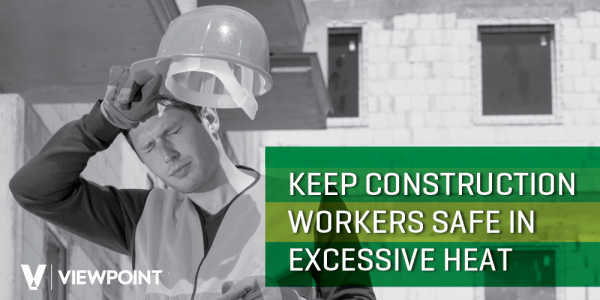7 Ways to Keep Construction Workers Safe in Excessive Heat
0%

It's a heatwave! With temperatures across the country and around the world hitting all-time record highs, keeping workers cool on the jobsite is safety tip #1.
Construction workers are at an elevated risk for heat-related injury and even death. More than 40% of heat-related worker deaths occur in the construction industry.
Regardless of physical condition, age, and tolerance, heat illnesses can affect anyone. Excessive heat can cause heatstroke or heat exhaustion, and just being overheated makes workers more susceptible to accidents or injuries.
As an employer, you’re responsible for protecting workers from risk—extreme temperatures and weather included.
Read on to see what you can do to beat the heat today!
7 Tips to Prevent Heat-related Illnesses

1. Understand and use the Heat Index
The heat index takes both temperature and humidity into account, measuring how hot it really feels. Working in heavy protective clothing and gear, coupled with hot sun, can intensify the heat even beyond what the index shows. As an employer, project manager, or site lead, pay attention to weather forecasts and keep the index handy. Also, keep in mind on hazy or cloudy days the temperature can be just as high and the humidity just as bad.
2. Account for acclimation
The first hot days of the year are most likely to have the strongest effect on workers. Schedule jobs to allow crews to gradually build up a heat tolerance.
3. Schedule heavy work during the cooler times of day
Early morning starts and evening or night shifts can take several hours off working in sweltering afternoon heat. Using time tracking integrated software will make it easy to see when workers are taking a lengthy weather-induced break (and where they are) so you can get everyone back on projects together and make sure teams are coordinating.
4. Consider job rotation
An efficient way to prevent heat exhaustion is to have workers share the more physically strenuous jobs, alternating those with lighter work. Also, keep in mind more workers may need to be scheduled on hot days to handle the same volume of work, to account for breaks and decreased productivity.
5. Allow and encourage frequent breaks and proper hydration
Workers should be drinking water every 15 minutes, if not more, during super hot days. Remind team members to keep water bottles close at hand, and to slow down and take a break if they’re feeling the heat. Provide fans throughout the jobsite, and if shade is at a premium on-site, supply umbrellas or canopies.
6. Educate the crew and watch for symptoms of heat-related illness
Provide reminders for the crew about what to watch for in themselves and others regarding heat-related illness. Cramping, confusion, excessive sweating, dizziness, or lightheadedness are just a few of the symptoms of heat sickness.
7. Have an emergency plan
Knowing how to respond to heat illness situations can make a huge difference in helping a victim. Have plenty of water and ice packs at the ready on the jobsite, and make sure all workers know where they are in case of emergency. Report any symptoms to supervisors so proper steps can be followed and care administered. Even if someone says they’re “fine,” reiterate to employees that following an instinct to report or help someone who may be dealing with heat illness can be a life or death decision.



